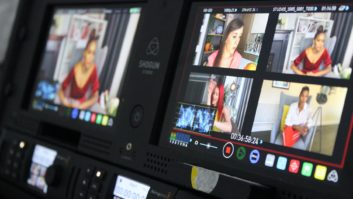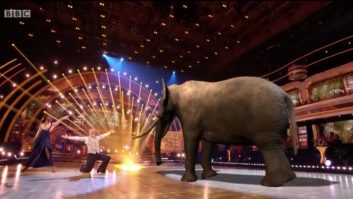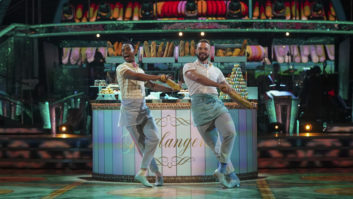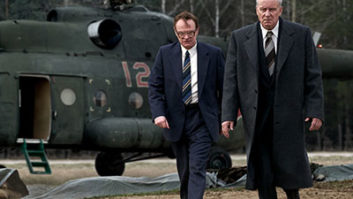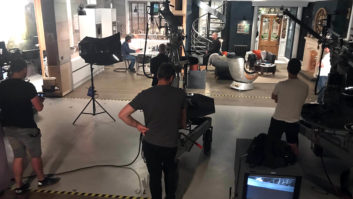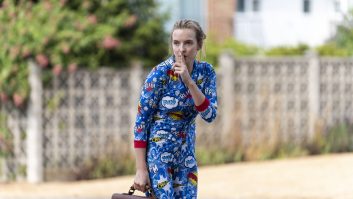Setting foot on to the set of Strictly Come Dancing is like stepping into a rainbow. Dozens of multi-coloured spotlights swirl and fizz in every direction, while LED displays and video screens bathe the room in a bubbling froth of luminescent pinks, purples, greens, blues and oranges. As we arrive to check out the rehearsals we find a beaming Anton Du Beke laughing and mopping his brow as he departs the dance floor following a run-through of his routine, soundtracked by a loud, brassy circus tune that’s being prepped for the next couple. It all stands in stark contrast to the oppressive, slate grey drizzle lurching over Borehamwood’s Elstree Studios on the day of our visit. It’s a Friday, which means we are 24 hours away from the live Saturday night broadcast. BBC Studioworks, the studio and post production provider for Strictly, has kindly invited us into the fray for a look behind the scenes and a chat with some of the key members of the sound department, including Andy Tapley, sound supervisor, BBC Studioworks, who has worked on the show for the best part of a decade.
He takes us on a comprehensive tour of the studio where we see and hear first hand precisely what goes into the making of an episode of Strictly. The collective effort of the production team is phenomenal, as they create an audiovisual spectacular that dazzles and sparkles like the contestants’ outfits, working to a schedule almost as tight.
“We divvy up the mixing because it’s such a big show,” says Tapley, referring to his broadcast mix partner and co-sound supervisor Richard Sillitto, as TVBEurope sits down with the pair in a bustling mixing room. “We have lots of circuits coming from the studio floor… it’s a busy show and it takes two of us to mix it. We use a system that has developed over the years as the production requirements have become bigger and bigger with each series. If you were to look back at the early days of the show you’d see it looks very different. It’s evolved a lot.” It certainly has. Now in its 17th series, Strictly has fought off stiff competition from numerous Saturday night prime time contenders to remain one of the most popular fixtures on the TV calendar. With each series the stakes are raised, and as the visual elements of the show are elevated, so too are the challenges placed on its sound team.
“We work closely with the visuals,” says Tapley. “It’s become more demanding in terms of the content we’re covering. From a music perspective, it’s very challenging. The music is incredibly diverse and has got more and more varied over the years.”
Sillitto elaborates: “There has been an ambition to incorporate more modern-produced tracks. It’s moved away from the band just doing a cover to much more often trying to recreate the track and getting it as close to the original as possible, albeit with a pit band.”
“The calibre of the musicians is a huge part of that,” Tapley continues. “Headed by Dave Arch, the 18 session musicians seamlessly switch between orchestral scores to produced pop. They are an amazing team, as are the sound team members working in the background; organising the radio mics, band, monitors and PA. It’s the professionalism of this team, and all teams on the show that make it possible.’’
To help us understand what a weekly cycle of Strictly from one Saturday to the next looks like, Sillitto provides a breakdown of his and Tapley’s schedule.
“Principally it starts for us on a Thursday when we have a planning meeting, where we’ll discuss what’s happening the following week,” he explains. “That’ll incorporate sound, lighting, props, everyone. Then Friday is spent with Howard Hopkins, deputy sound supervisor playing in commercial tracks, cameras can rehearse and it’s a good time for me and Andy to have a listen to the tracks. Later this evening, all the cameras will go home and the rhythm section of the band will arrive, and we’ll run through all the tracks, building up snapshots and then we’ll come in on Saturday, have 15 minutes with the band to add the front line and start rehearsing with the couples. So then the couples will dance for the cameras with the live band, which gives us another two hits with them. Later on in the day we’ll do a dress rehearsal, then it’s live to air. Then we forget all about that and start again!”
Presumably, as the show rolls on and couples are eliminated, the process becomes easier. Not so says Tapley. “You’d believe that was the case, but you have to factor in that every week there might be another group dance or some special event, like Halloween,” he tells us. “In theory, it should get easier but it never actually does because there are always additional challenges. And in a couple of weeks we’re off to Blackpool. We pack up everything and rebuild it in the Blackpool Tower Ballroom. It’s a big show to take on the road. Then it’s back here, where we rebuild everything again and then it’s the Christmas show. It’s a juggernaut production that starts at the end of August and goes through to Christmas and it’s only then that you take a breath.”
“Most of the people who work on the show across all departments have been with it for many years, so it’s built quite a nice family feel,” Sillitto adds. “Everyone is very supportive of one another and we’re always discussing things with other departments to see how we can help each other or get through problems. That’s what makes it work.”
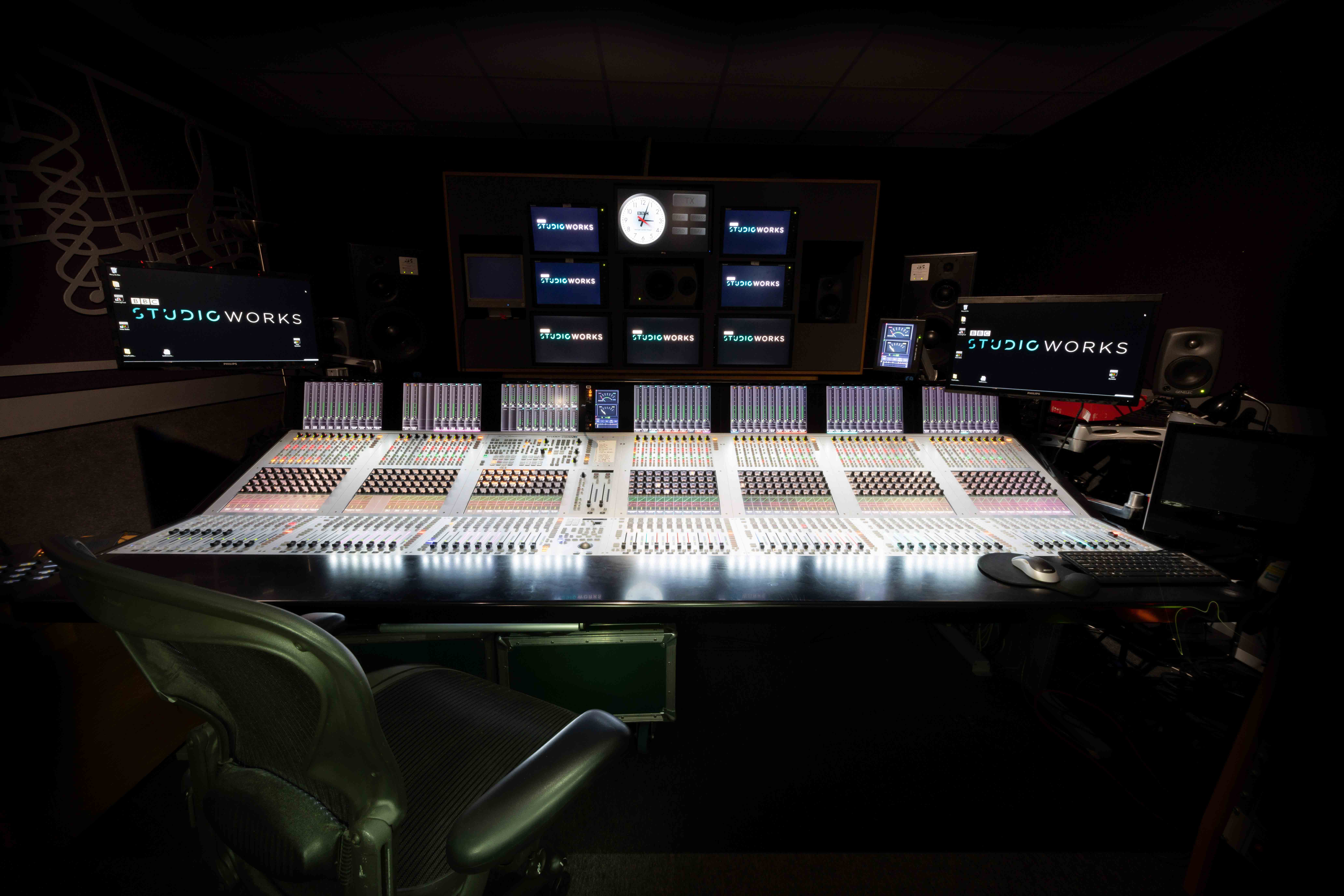
As for the process of mixing the show, Tapley and Sillitto have become accustomed to the studio’s Studer Vista X console, which, they tell us, is vital in bringing the show to life for the audience at home.
“The desk enables you to very dynamically position faders where you want them and to allocate on an ad-hoc basis,” says Tapley. “We actually have six stage boxes in the studio, which are feeding back about 180 circuits from the studio, so that’s about 80 inputs from the band, 50-60 radio mics, audience mics, then there’s all the tracks for visiting bands, etc. All of that comes into the desk and we divide it into sections. At one end I have different layers, so I have the drum kit on one layer, guitars, keyboards, percussion, trumpets, sax, it’s set up in a way that I’m very familiar with so I can switch between them. I’m actually using half of the physical surface to mix the band and then, when the music’s over, I jump to another layer with couples’ mics and Rich will be across the main presenters’ mics at his end of the desk.”
Sillitto picks up: “At my end of the desk I’ve got the fader that is the audience, a couple of VT replay lines, the presenters and the four judges, so my hands are already pretty full with that. Then I’ve got all live vocals, so four vocal mics, various sends to effects units, guest mics. I also have a few standby things – because it’s a live show we have to prepare for things that could go wrong, so we have these standbys that we call our ‘ultimates’. They are a couple of mics on a bit of copper cable straight into the desk, so if all the RF and stage boxes fall over, we have something to go to!’’
“On the layers below, I have all the couples’ mics, so if for some reason Andy can’t get to them I have them all grouped together. I also manage things like the Timecode. So the Timecode can come in from various sources – from grams, from the band, from the QLab playback system we have for guest acts. Snapshots are a vital feature and Timecode switching is one of the things that gets switched with the Snapshots, so when we pull back a particular track it chooses where the Timecode comes from and sends it off to everyone who needs it all from one point.”
Equal to the challenge of mixing for the audience at home is mixing FOH for the live studio audience. For the past nine years, the task has been handled by audio solution provider Plus 4 Audio, and at the helm Nick Cook. During his time on the show he has seen production values grow consistently, often forcing speaker placement further and further to the periphery to accommodate increasingly elaborate staging and use of props.
“Nine years is a long time and things grow and change,” Cook says as we join him at the mixing desk overlooking the dancefloor. “The band by and large has pretty much stayed the same, but the amount of inputs and complexity of the performances has grown. We go from dance tracks to skiffle tracks to charleston, to rave… things need to be flexible. For each guitarist we’ve got an acoustic line, an electric line and a banjo line. This keeps things as separated as possible and gives us optimum control over it – it is similar to many parts of the band and the channel count keeps growing!
“This is our seventh year at Elstree and it’s a bigger room here, so the set is slightly higher so our box count went up slightly,” he continues, discussing the more challenging aspects of his role. The PA has to go higher than we would usually like but it has to clear all of the camera shots and we also work closely with lighting to clear any follow spot shots. It’s a challenge, but at Plus 4 we’re all very aware of the environment we’re working in and need to be sympathetic to it.
“There’s lots of zoning – where the judges are sitting we split the hangs to give us maximum flexibility for those mics. We have to keep it nice and clean but it can be challenging due to time constraints. We don’t see the band until Friday night, so before we do it live on TV we might cram in five or six passes of each song. Also, the costumes change every week, so unlike theatre where the mics are always in the same position, they’ll change week-on-week or day by day.”
So what’s the setup? “I use a Digico SD7,” he says. “It has in excess of 160 inputs and I do all of the system work on this as well – I send out to multiple matrices to give myself maximum control. This means that when things are thrown at me at the last minute, as they often are, the system has the flexibility to adjust certain elements of the PA and get plenty of level whilst keeping a clean sound for Richard and Andy in broadcast.
“The PA, which is an almost ‘in the round’ system, features L-Acoustics Kiva II boxes, which are perfect for the environment, and I have APG UL118 subs to give us a nice bit of warmth and energy.”
He continues: “Ultimately, my job is to make sure the audience are getting a show experience whilst being very aware of the broadcast requirements. If they can’t hear the presenters they can’t react; if they can’t hear the jokes they can’t laugh etc, it’s very important that everybody can hear the dialogue so that Andy and Richard can capture that room environment for TV. If everyone’s having a good time here, everyone at home will hear and feel it. At the end of the day, sound matters.”
Like Tapley and Sillitto, Cook is also keen to address the ‘family feel’ that has been cultivated throughout Strictly’s various production departments. “We’re always sharing ideas and working together, from band mic positions to foldback mixes and levels to PA EQ and content. It sounds cheesy but we’re a proper family and we work really closely together.”
Before departing the warm, candy store glow of the studio for the gloom that awaits outside, we run into one of the show’s RF specialists, Adam Waller, an employee of RF provider Terry Tew, which looks after all of Strictly’s radio mics and IEMs. It’s an incredibly complex and challenging aspect of the show, made all the more difficult by Ofcom’s clearing of 700MHz spectrum.
“Obviously there is a lot of stuff going on onsite,” Waller says. “From an RF perspective, the challenges come in available spectrum onsite, as well as RF generated by other stuff, like LED walls, lighting kit, anything that emits RF can cause us a problem. It’s getting better as kit gets better, but obviously Ofcom has gotten rid of a load of spectrum this year, which has presented huge challenges on this show. The current plan, having invested heavily in new kit, is to shift into DME spectrum (900MHz upwards), which is currently clean spectrum. The plan is that the next series will be fully digital.”
Despite the highly technical nature of Waller’s job, some of the most taxing tasks he faces stem from a far simpler place.
“The biggest challenge with this show, RF aside, is pack position, size of pack and battery life,” he tells us. “The pack gets sewn into costumes in the morning and has to last out the record, so battery life is a huge consideration. And on this show, dancers can’t wear packs, where you would usually expect a pack to be worn. Some are worn on the back, but some are worn in other places…
“As for the gear we use, for quite a few years now it’s been Sennheiser 1046s,” he continues. “They hold on for dear life and are very easy to manage. In a live show when you’re on air you can look across the rack and you can see very quickly if there is a problem. And we use the little 5212 packs. They are obviously very small so work for the positioning on a dancer.”
Throughout our visit, the team are welcoming, happy to chat about their work and seem thoroughly relaxed despite the vastness of the job in hand. There’s still plenty of work to be done ahead of the Saturday night show but, predictably, it goes off without a hitch. For the Strictly team it’s business as usual. “It’s hard work, but it’s such a fun show to work on,” Tapley reiterates as we say goodbye. “We wouldn’t have it any other way.”
